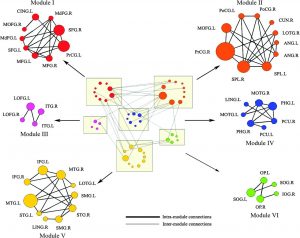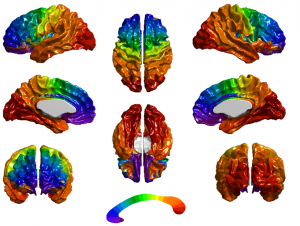
Characterizing the underlying architecture of brain networks is central to current neuroimaging research. Mathematical modeling provides generalizable definitions for the structural and functional organization of the human brain. These models aim to provide objective biomarkers for the processes by which the brain generates and integrates information from multiple sources at various spatiotemporal scales at one time (as measured by fMRI) or over time (as measured by diffusion tensor imaging or structural covariations in other anatomical MRIs).
Different methods are being developed to study inter-regional connectivity or the graph-theoretical properties of the brain in different studies of neurodevelopment and neurodegenerative diseases.
Key Publications
Key Publications
–Lerch JP, Worsley K, Shaw WP, Greenstein DK, Lenroot RK, Giedd J, Evans AC (2006) Mapping anatomical correlations across cerebral cortex (MACACC) using cortical thickness from MRI. Neuroimage 31:993-1003.
–He Y, Chen ZJ, Evans AC (2007) Small-world anatomical networks in the human brain revealed by cortical thickness from MRI. Cereb Cortex 17 (10): 2407-2419.
–He Y, Chen Z, Evans AC (2008) Structural insights into aberrant topological patterns of large-scale cortical networks in Alzheimer’s disease. J Neurosci 28(18):4756-66.
–Evans, AC (2013) Networks of anatomical covariance. Neuroimage 80:489-504.
–Chen ZJ1, He Y, Rosa-Neto P, Germann J, Evans AC (2008) Revealing modular architecture of human brain structural networks by using cortical thickness from MRI. Cereb Cortex 18(10):2374-81.
–Gong G, He Y, Chen ZJ, Evans AC (2012) Convergence and divergence of thickness correlations with diffusion connections across the human cerebral cortex. Neuroimage 59(2):1239-48.
–Gong G, Rosa-Neto P, Carbonell F, Chen ZJ, He Y, Evans AC (2009) Age- and gender-related differences in the cortical anatomical network. J Neurosci 29(50):15684-93.
–He Y, Dagher A, Chen Z, Charil A, Zijdenbos A, Worsley K, Evans A (2009) Impaired small-world efficiency in structural cortical networks in multiple sclerosis associated with white matter lesion load. Brain 132(Pt 12):3366-79.
–Reid AT, Evans AC (2013) Structural networks in Alzheimer’s disease. Eur Neuropsychopharmacol 23(1):63-77.
–Khundrakpam BS, Reid A, Brauer J, Carbonell F, Lewis J, Ameis S, Karama S, Lee J, Chen Z, Das S, Evans AC (2013) Developmental changes in organization of structural brain networks. Cereb Cortex 23(9):2072-85.
–Lewis JD, Theilmann RJ, Townsend J, Evans AC (2013) Network efficiency in autism spectrum disorder and its relation to brain overgrowth. Front Hum Neurosci 7:845.


